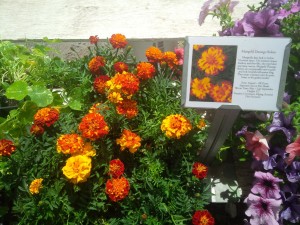Way back in 1939 Ethel Water’s sang a set of torrid lyrics written by Irving Berlin. The first line goes:
`“Oh, we’re having a heat wave, a tropical heat wave.”
Many of us are singing that song right now.
Berlin’s “heat wave” was generated by an unnamed human temptress. Our current heat wave is generated by Mother Nature. Unless you have an in-ground sprinkler system, a network of soaker hoses, or are getting your daily exercise by moving a lawn sprinkler around your property, your garden is in danger of becoming a collection of crispy critters. The peril grows as the heat wave lengthens. It is enough to make you pray for an old-fashioned gulley washer.
Inevitably some plants will die. Gardeners tend to suffer grief, guilt and self-doubt when this happens, but it is important to remember that plants will die even under the best of circumstances. It has happened to me many times over my long gardening career.
I have killed plants in every category except trees, and that is only because I haven’t planted large numbers of trees. Annuals have withered, perennials languished unto death, and shrubs declined into leaflessness. Sometimes these deadly incidents were my fault; other times the causes were mystifying.
Tony Avent, proprietor of the Plant Delights Nursery in North Carolina, has long said that you should not give up on a plant until you have killed it at least three times. I don’t usually have the patience to try a particular variety three times. One death generally convinces me, but if that death was my fault, I will give the plant another try.
So what do you do when a plant dies? First of all, you can grieve, but not for too long. After all, every dead plant opens a space in the garden for something new and different. Second, try to figure out what went wrong. Sometimes you can see damage from insect or animal pests or evidence of disease. If a plant is really worth it, try again, but protect it with physical barriers like deer or rabbit fencing, or organic repellant sprays.
If you have taken good care of a plant and it is not threatened by obvious pests or diseases, think about the plant’s situation. Sun lovers may languish in shade; shade lovers may get singed by the sun’s harsh rays. Prevent this by reading plant tags carefully and observing the specimen—especially when it is new. Try moving it for a week or so and see if there is any change. Sometimes this is all that is needed.
Soil chemistry and composition also play a role. Some plants, like lavender, need excellent drainage. If your soil is light, sandy or full of small pebbles, the lavender will probably be happy. If your soil is heavy clay and holds water tenaciously, lighten it with sand, or lots of organic material like compost. Actually, organic matter is helpful whether your soil drains too quickly or not fast enough. When in doubt, add it to planting holes.
Water is important even when Mother Nature is not systematically depriving us of it. More plants have been killed by overwatering than by any other cause. Many of the most popular plants—especially the currently-hot succulents—will rot and die if they are overwatered. If plant tags don’t give you enough watering information, go online and check out the requirements. Some plants, like hydrangeas, are perennially thirsty. Others, like annual portulaca, should not be watered until the top inch or so of soil is dry.
If a plant is properly sited and watered appropriately, it’s likely the plant was sick when it came from the nursery. Plant diseases don’t always show themselves right away. Diseased roses, for example, may look great in the nursery and even appear to thrive the first year, before dying in Year Two. The killer was hiding in the rose plant long before you purchased it.
These days, plants are most often bred to look good on the plant pallets during the growing season. Frankly, some are bred to be disposable, but that may not be immediately apparent to the gardeners who buy them. The best insurance against this is to shop at a reputable nursery that takes care of its inventory. Big-box stores can offer great bargains—and I often take advantage of those bargains–but generally plant care is not high on their list. When a plant stops blooming, it goes to the back of the nursery area, to be replaced by something that has arrived in a more recent shipment and is about to burst into bloom. For best results when you shop at the big-box stores, buy plants that have been delivered within the last seven days.
If plants die on you, remember that gardening should be about discovery, not guilt. Garden equipment is heavy enough without the added weight of lugging around the burden of guilt. We all have our horticultural bêtes noir. Mine happens to be ornamental sweet peas. Sometimes I blame my lack of success on climate, which is certainly a factor. However, I also seem to have bad sweet pea karma. I have accepted that and moved on to things that succeed better in my garden. If you are discouraged by plant mortality, I recommend finding a different route to success. Everyone can grow something—usually many somethings. The only thing to fear is fear of plant death.
